Dear Zazie, Here is today’s Lovers’ Chronicle from Mac Tag to his muse. Visit us on twitter @cowboycoleridge. Ciao, Rhett
The Lovers’ Chronicle
Dear Muse,
© copyright 2021 mac tag/cowboy coleridge all rights reserved
© copyright 2019 mac tag/cowboy coleridge all rights reserved
here again
to choose you
only one way
to close these thoughts
and the path that leads them
where they must go
perhaps
some sort of madness,
but is there not
some reason as well
whatever it is that pulls,
past the ordinariness
even for a moment,
it is enough
listen still
© copyright 2018 mag tag/cowboy coleridge all rights reserved
on the prairie
at night alone
stars comin’ on
thinkin’ the thoughts
that interweave
the possibilities
and choices
that await
what now, which way
wherefore i threw a wish
to find out if i might
and listen still
to find out all there is
and is not
certainly i
be listenin’ for you
till the stars fade away
and the shadows take the moon
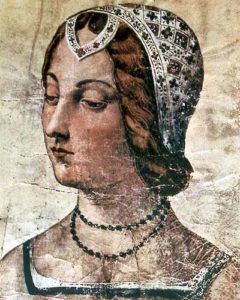
Laura de Noves
Today, a day in history story of unrequited love, my favorite kind. On this day in 1374, scholar, poet, humanist, “The Father of Humanism”, “The Father of the Renaissance”, Petrarch died at his home in Arquà Petrarca, Veneto, Italy one day before his 70th birthday. Born Francesco Petrarca on 20 July 1304 in Arezzo, Tuscany, Italy. He rediscovered many Ancient Greek and Roman writers and his belief that there was no real conflict between Classical and Christian thought anticipated the Renaissance spirit. He did not see a conflict between realizing humanity’s potential and having religious faith. Petrarch is perhaps best known for his Il Canzoniere (Song Book) a collection of 366 poems which address his lifelong unrequited love for a mysterious woman named Laura. In many of these he developed and perfected the sonnet form, and the “Petrarchan sonnet” still bears his name. Apparently, on 6 April 1327, Good Friday, the sight of a woman called “Laura” in the church of Sainte-Claire d’Avignon awoke in him a lasting passion. Laura may have been Laura de Noves, the wife of Count Hugues de Sade (an ancestor of the Marquis de Sade). According to his “Secretum”, she refused him for the very proper reason that she was already married to another man. Petrarch channeled his feelings into love poems. Upon her death in 1348, he found that his grief was as difficult to live with as was his former unrequited longing. Later in his “Letter to Posterity”, Petrarch wrote: “In my younger days I struggled constantly with an overwhelming but pure love affair – my only one, and I would have struggled with it longer had not premature death, bitter but salutary for me, extinguished the cooling flames. I certainly wish I could say that I have always been entirely free from desires of the flesh, but I would be lying if I did.” The Romantic composer Franz Liszt set three of Petrarch’s Sonnets (47, 104, and 123) to music for voice, Tre sonetti del Petrarca, which he later would transcribe for solo piano for inclusion in the suite Années de Pèlerinage.
Today is the birthday of Edgar Degas (born Hilaire-Germain-Edgar De Gas, Paris; 19 July 1834 – 27 September 1917 Paris); artist of paintings, sculptures, prints, and drawings. He is especially identified with the subject of dance; more than half of his works depict dancers. He is regarded as one of the founders of Impressionism, although he rejected the term, preferring to be called a realist. His portraits are notable for their psychological complexity and for their portrayal of human isolation. At the beginning of his career, Degas wanted to be a history painter, a calling for which he was well prepared by his rigorous academic training and close study of classic art. In his early thirties, he changed course, and by bringing the traditional methods of a history painter to bear on contemporary subject matter, he became a classical painter of modern life.
He never married and spent the last years of his life, nearly blind, restlessly wandering the streets of Paris.
Gallery
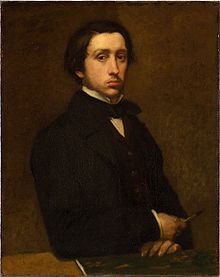
Self-portrait (Degas au porte-fusain), 1855






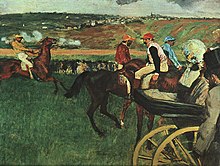



-

Achille De Gas in the Uniform of a Cadet, 1856/57, National Gallery of Art, Washington D.C.
-
The Bellelli Family, 1858–1867, Musée d’Orsay, Paris
-

Young Spartans Exercising, c. 1860–62, National Gallery, London
-
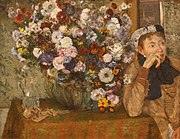
Woman Seated beside a Vase of Flowers, 1865, oil on canvas, Metropolitan Museum of Art, New York City
-
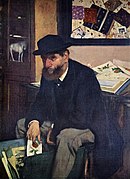
The Amateur, 1866, The Metropolitan Museum of Art, New York City
-

Édouard Manet and Mme. Manet, 1868–1869, Kitakyushu Municipal Museum of Art, Japan
-

Dance Class, 1871, The Metropolitan Museum of Art, New York City
-

Ballet Rehearsal, 1873, The Fogg Art Museum, Cambridge, Massachusetts
-
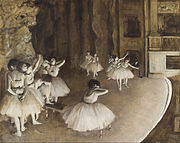
Rehearsal on Stage, 1874, Musée d’Orsay, Paris
-

Portrait of Miss Cassatt, Seated, Holding Cards, 1876–1878
-

At the Café-Concert: The Song of the Dog, 1875–1877
-
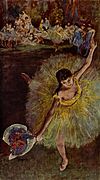
Fin d’Arabesque, with ballerina Rosita Mauri, 1877, Musée d’Orsay.
-

The Singer with the Glove, 1878, The Fogg Art Museum, Cambridge, Massachusetts
-

Miss La La at the Cirque Fernando, 1879, The National Gallery, London
-
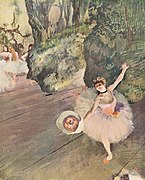
Dancer with a Bouquet of Flowers (Star of the Ballet) (with also ballerina Rosita Mauri), 1878
-

Stage Rehearsal, 1878–1879, The Metropolitan Museum of Art, New York City
-

Woman in Street Clothes, Portrait of Ellen Andrée, 1879, pastel on paper
-

Waiting, pastel on paper, 1880-82.
-

Before the Race, 1882–84, oil on panel, The Walters Art Museum, Baltimore
-
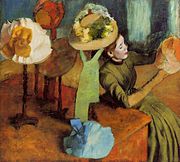
The Millinery Shop, 1885, The Art Institute of Chicago
-
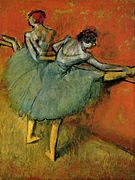
Dancers at The Bar, 1888, The Phillips Collection, Washington, DC
-

Woman in the Bath, 1886, Hill-Stead Museum, Farmington, Connecticut
-

The Tub, 1886, Musée d’Orsay, Paris, France
-

The Bath: Woman Supporting her Back, c. 1887, pastel on paper, Honolulu Museum of Art
-

Kneeling Woman, 1884, Pushkin Museum, Moscow
-
Three Dancers in Yellow Skirts, circa 1891, oil on canvas, The Detroit Institute of Arts
-

After the Bath, Woman Drying her Nape, pastel on paper, 1898, Musée d’Orsay, Paris
-

After the Bath, Woman Drying Herself, c. 1884–1886, reworked between 1890 and 1900, pastel on wove paper, 40.5 x 32 cm, Musée Malraux, Le Havre
Of course the song of the day is Liszt’s “Tre sonetti di Petrarca”, I´vidi in terra. Luciano Pavarotti, tenor. John Wustman, piano. http://www.youtube.com/watch?v=bU3E5FjtZh8
All for you muse,
Mac Tag
Only Death can close from my thoughts
the loving path that leads them
to the sweet doorway of their blessing.
– Petrarch
There is always some madness in love, but there is also always some reason in madness. ~ Petrarch
And here choose i; joy be the consequence! – Shakespeare
Whatever it is that pulls the pin, that hurls you past the boundaries of your own life into a brief and total beauty, even for a moment, it is enough. – Jeanette Winterson



No Comments on "The Lovers’ Chronicle 19 July – listenin’ – death of Petrarch – art by Edgar Degas"